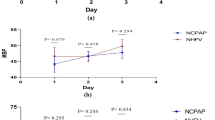Abstract
Objective
To compare the effect of suctioning first or drying first on the composite outcome of hypothermia or respiratory distress in depressed newborns requiring delivery room resuscitation.
Design
Open-label, randomized, parallel-group, controlled trial.
Setting
Delivery room and neonatal intensive care unit of a tertiary-care teaching hospital.
Patients
Depressed newborns (n=154) requiring initial steps of resuscitation at birth.
Intervention
During delivery room resuscitation eligible newborns were randomly allocated to receive either suctioning first or drying first (77 newborns in each group).
Main outcome measure
Composite incidence of hypothermia at admission or respiratory distress at 6 hours of age.
Results
Both groups were comparable with regard to maternal and neonatal characteristics. Composite outcome was similar in both the groups [46 (59.7%) vs 55 (71.4%)] in suctioning first and drying first, respectively [RR (95% CI), 0.84 (0.66–1.05); P=0.13]. Incidence of hypothermia, respiratory distress at admission and oxygen saturation at 6 hours were also similar. On admission to NICU, hypothermia was observed in 26 (33.8%) neonates in suctioning first group and 33 (42.8%) neonates in drying first group but by one hour of age the proportion of hypothermic neonates was 13 (16.9%) and 14 (18.1%), respectively.
Conclusion
In newborns depressed at birth, the sequence of performing initial steps, whether suctioning first or drying first, had comparable effect on composite outcome of hypothermia at admission or respiratory distress at 6 hours of age.
Similar content being viewed by others
References
Barber CA, Wyckoff MH. Use and efficacy of endotracheal versus intravenous epinephrine during neonatal cardiopul-monary resuscitation in the delivery room. Pediatrics. 2006;118:1028–34.
Black RE, Cousens S, Johnson HL, et al; Child Health Epidemiology Reference Group of WHO and UNICEF. Global, regional, and national causes of child mortality in 2008: A systematic analysis. Lancet. 2010;375:1969–87.
Wyckoff MH, Aziz K, Escobedo MB, et al. Part 13: neonatal resuscitation: 2015 American Heart Association Guidelines Update for Cardiopulmonary Resuscitation and Emergency Cardiovascular Care. Circulation. 2015;132: S543–60.
Sodemann M, Nielsen J, Veirum J, Jakobsen MS, Biai S, Aaby P. Hypothermia of newborns is associated with excess mortality in the first 2 months of life in Guinea-Bissau, West Africa. Trop Med Int Health. 2008;13:980–6.
Miller SS, Lee HC, Gould JB. Hypothermia in very low birth weight infants: Distribution, risk factors and outcomes. J Perinatol. 2011;31:S49–56.
Mullany LC, Katz J, Khatry SK, LeClerq SC, Darmstadt GL, Tielsch JM. Risk of mortality associated with neonatal hypothermia in southern Nepal. Arch Pediatr Adolesc Med. 2010;164:650–6.
Neonatal Resuscitation: India. 1st ed. National Neonatology Forum of India; 2013.p.5.
Neonatal Resuscitation Module. Facility Based Newborn Care: Ministry of Health and Family Welfare, Government of India, New Delhi;2014. p.9–16.
Kumar R, Aggarwal AK. Body temperatures of home delivered newborns in north India. Trop Doct. 1998; 28: 134–6
Kaushik SL, Grover N, Parmar VR, Kaushik R, Gupta AK. Hypothermia in newborns at Shimla. Indian Pediatr. 1998; 35: 652–6.
Bang AT, Reddy HM, Deshmukh MD, Baitule SB, Bang RA. Neonatal and infant mortality in the ten years (1993 to 2003) of the Gadchiroli field trial: effect of home-based neonatal care. J Perinatol. 2005; 25(Suppl 1): S92–107.
Author information
Authors and Affiliations
Corresponding author
Additional information
Contributors
AK, SB: conceptualized and designed the study, coordinated and supervised data collection, drafted the initial manuscript, and reviewed and revised the manuscript; RPY: designed the data collection instruments, collected data, carried out the initial analyses, and reviewed and revised the manuscript; TBS: analyzed the data, and reviewed and revised the manuscript. All authors approved the final manuscript as submitted and agree to be accountable for all aspects of the work.
Ethical clearance
Institutional Ethics Committee of Institute of Medical Sciences, BHU; No. Dean/2014-15/EC/1455 dated 17 October, 2015.
Funding
None
Competing interests
None stated.
Rights and permissions
About this article
Cite this article
Kumar, A., Yadav, R.P., Basu, S. et al. Suctioning First or Drying First During Delivery Room Resuscitation: A Randomized Controlled Trial. Indian Pediatr 58, 25–29 (2021). https://doi.org/10.1007/s13312-021-2091-z
Received:
Revised:
Accepted:
Published:
Issue Date:
DOI: https://doi.org/10.1007/s13312-021-2091-z




